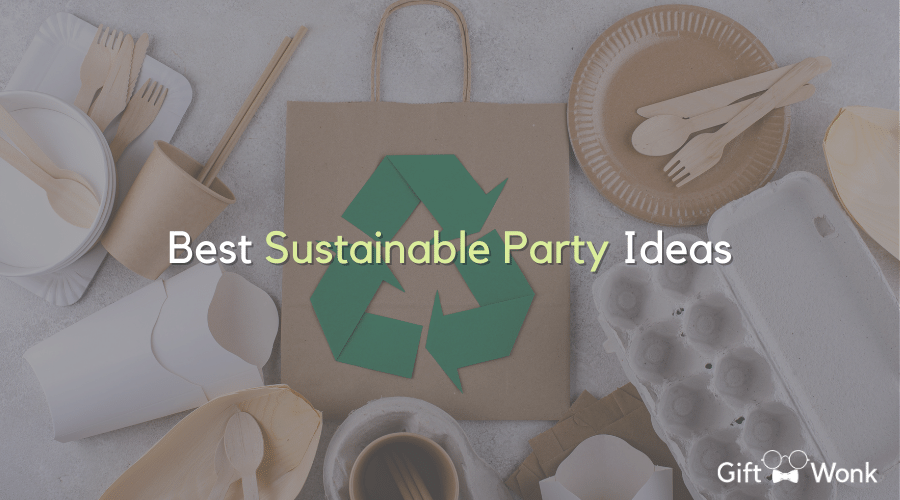
!! DISCLAIMER !! This site may contain Amazon & other affiliate links.
This means if you click on one of the product recommendation links, this site may receive a small commission. This is at no extra cost to you and may include exclusive discounts when possible. This helps support this site and allows us to keep making content like this. Thank you for your support!
Sustainable Party Ideas For Every Occasion
Going green is more than a fad. It’s a new way of living that parties needs to embrace. These sustainable party ideas will demonstrate that there is no reason to be scared by the thought of organizing a sustainable party. Awareness of your carbon footprint is the first step toward significant improvements.
After you’ve gone through all of these suggestions, you’ll be ready to host a party that everyone will envy!
Right now, sustainability is a major trend in the world of events. However, changing learned habits or ways of working is difficult. Even more difficult is persuading sponsors and audiences that doing good for the environment is beneficial for business.
When planning a green party, one important thing to remember is to reconsider the term sustainable and instead aim for regenerative.
With that in mind, here are the ways to host a greener party and lower your carbon footprint:
Go Digital!

Virtual parties are one of the finest solutions for party organizers looking to reduce their carbon footprint. If a meeting had been held in person, airfares alone would have caused so many emissions of the entire virtual conference.
When you include ground transportation, hotel, and housing energy, food manufacturing, and venue energy, you’ll discover that hosting a virtual party dramatically reduces each of those carbon emissions.
If you’ve decided to go virtual, consider informing your attendees about how this transition has benefited them by comparing each event’s sustainability achievements year after year. This is an excellent approach to showcasing and celebrating your event’s less significant outcomes for participants to observe.
Consider Going Hybrid
If becoming completely virtual isn’t an option for your event, a hybrid approach is the next best thing! By definition, hybrid event design is more environmentally friendly. Whatever hybrid event you decide to host, having a percentage of your audience participate remotely will naturally reduce your event’s carbon footprint.
It may be feasible to reduce emissions by combining online and in-person hybrid conferences, especially if participants are located far away, promoting land-bound travel, even if this means longer travel times than flying.
Similar to virtual events, hybrid events are an ideal choice for sustainability due to lower carbon emissions from air and ground transportation, hotel and lodging, food production, venue energy, and material waste.
How can your carbon footprint be tracked and compared to past events? Calculate the intensity of emissions by dividing the total emissions by the number of participants. If the number falls, the event is becoming more environmentally friendly.
Choose Eco-Friendly Event Locations
A green event venue is one that proactively seeks to improve its sustainability and fulfill specific sustainability rules. One of the first things to search for in a green event location is certifications for sustainability.
Certifications to search for include the Leadership in Building Owners, and Managers Association Building Environment Standards (BOMA BESt), Energy and Environmental Design (LEED), IACC Green Star, and others.
If sustainability certifications are not available in the area where you plan to hold an event, make a list of sustainable requirements for your venue, such as renewable energy sources, the use of reusable or compostable utensils and plates, a venue designed to maximize natural lighting, and the use of best practices for energy efficiency, such as motion-controlled light switches.
Choose Eco-Friendly Event Vendors
Has built a non-exhaustive and open-sourced directory of sustainable event vendors with the support of their fantastic network of event planners to make the search for the appropriate green event venue even easier. You may find a list of sustainable vendors for your event that has already been validated.
Consider Accessible Locations
When it comes to selecting an event site, even if it meets the sustainability guidelines, it won’t matter if your guests have to travel great distances and utilize inefficient transportation means to get there.
All of your efforts in selecting a green venue will be effectively nullified by all of the carbon emissions your guests will emit just to get to your venue.
This is why selecting a location that is conveniently accessible by public transportation or a short plane or train travel is important.
If it is not possible because you are having an international or regional event, select a location near a transportation hub, such as an airport or a central train station.
Another option is to hire eco-friendly hybrid or electric vehicles to transport your attendees to your destination.
Communicate the pickup places to your participants to avoid confusion and to reduce the need for your attendees to rely on their own vehicles. Whatever you choose, the less hassle and distance your attendees must go to reach your venue, the better.
Encourage The Use Of Public Transit And Carpooling

If you have chosen a location that is easily accessible by public transit, make sure to promote this to your attendees actively! If you do not inform your participants that public transit is readily available to them, they are likely to ignore this and find their own way to your event.
Do the homework for your participants and distribute a detailed map with bus and rail itineraries via social media or email to all attendees. Include fare prices or share a link to a fare calculator if the information is accessible.
If you can’t find a place with accessible public transit, try incentivizing carpooling. Offering closer parking for carpools, discounted parking for carpools, or discounted event tickets are some examples of incentives.
Conduct Surveys To Learn How People Go To Your Event
A pre-event survey sent to your guests will inform you how far individuals are traveling to attend your event.
You may get a more detailed sense of where the majority of your event participants are coming from by asking for something as generic as a postal or zip code. This data can be beneficial when determining the accessibility of your next event location.
A post-event survey can inquire about how guests got to your event (i.e., carpool, public transportation, private car, and so on).
You can use this data to determine whether your messaging about public transit choices was effective, as well as whether your venue was actually as accessible as you had anticipated. The results of both surveys can help you make future decisions about accessibility, shuttles, and carpooling.
Select A Place That Has LED Lighting

Check with the venue that will be hosting your event to see if they are using LED light bulbs to save energy while hosting your event. If they aren’t, now is a great time to persuade them or find a different venue.
Although LED lighting is more expensive than incandescent bulbs at first, the long-term benefits vastly outweigh the initial expenditures.
LED lights, for example, can last up to 20-25 years, are 100 percent recyclable, are free of harmful chemicals, can work in high temperatures, and the amount of times you turn the light bulb on or off has no effect on its longevity.
Furthermore, LED lighting delivers more constant and brighter illumination for your event venue, resulting in a better overall experience for your attendees.
Recyclability

Recycling is described as the action or process of transforming garbage into useful material, and it is a traditional green effort to look for while planning your event. Having said that, not every location or region has the same recycling procedures or facilities.
When choosing a venue or caterers, ensure that they have an effective recycling scheme in place. If they do not, be explicit about your recycling requirements and inquire whether they can recycle paper, cardboard, glass, tins, plastic, or cooking oil.
Also, be clear about pricing and inquire whether there is a cost involved with their recycling program that is separate from their regular running expenditures. If regional recycling facilities ban them, ask if you can send the plastics to specialized recycling centers.
Composting

Composting is the natural process of recycling organic matter, such as leaves and food scraps, into a beneficial fertilizer that can improve soil and plants.
Composting is a very efficient approach to help your event go green by reducing trash and provides a range of environmental benefits, such as enhancing soil health, reducing greenhouse gas emissions, recycling nutrients, and mitigating the impact of droughts.
Create a complete composting guide for events that include detailed information (including suggestions and best practices) to assist you in meeting your sustainability objectives.
The essential takeaways are to match products to infrastructure, plan ahead of time, explain goals and expectations to vendors and guests, and assist both groups along the process.
Despite your best efforts, diverting all of your event’s compost isn’t always easy. Therefore, event planners and composters should meet after the event to discuss. They should discuss what worked and what didn’t and use their expertise to improve the next event.
Reduce The Use Of Single-Use Items

An easy way to reduce an event’s carbon footprint is to reduce the use of single-use items. Disposable plates, cutlery, plastic straws, bags, balloons, coffee stirrers, food packaging, plastic beverage bottles, and other single-use products are examples.
Their environmental impact is significant since single-use plastics never entirely degrade, instead of deteriorating and forming microplastics that continue to destroy wildlife and the ecosystem.
Instead of plastic or styrofoam dishes, consider using reusable, recyclable, or biodegradable tableware.
Also, instead of using plastic beverage bottles, have sterilized cups with an automatic beverage dispenser on hand. This is not only better for the environment, but it also reduces your overhead costs because you are not paying to bring in items for your event.
Reduced reliance on single-use items is understandably problematic in a post-covid environment due to heightened cleanliness requirements.
If you must utilize single-use materials for your event, use biodegradable or compostable options. Biodegradable coffee cups, compostable plates and cutlery, napkins made from recycled content, and so on are examples.
Unfortunately, most event planners are unaware that specific processing is necessary and feel that simply labeling a product box as compostable or biodegradable is sufficient. To make matters even more complicated, goods permitted for composting in one location may not be accepted for composting in another.
Everything is dependent on infrastructure and what a processor will take as feedstock. This is a vital factor to consider when you plan your event, so make sure you follow up with your waste management contractor.
Plan For Needed Garbage Disposal
All of your recycling and composting initiatives will fail if you do not have effective waste management logistics in place. This is why you must have branded bins that are easily accessible throughout your venue, as well as clear and informative signs.
Make sure your signs are at eye level and not at the bottom of the bin. Also, limit the aperture of your bins so that it corresponds to what is supposed to be thrown in there, such as round apertures for cans and bottles or smaller slits for paper. People will think twice before throwing stuff in your bins because of the varied coverings.
Ascertain that your contractor is open and honest regarding what happens to your waste following the event. The contract should require them to report on waste and recycling locations.
Nothing is more discouraging than thinking you’ve done your part to help the environment when you haven’t made any improvements at all. This will help keep your contractors honest because they will know you will be following up with them on their vow and obligation to properly recycle and compost.
Eco-friendly Catering

Sustainable catering, at its most basic, focuses on ecologically mindful techniques of sourcing, preparing, serving, and disposing of food and materials. What does this imply for you, the planner?
Look for caterers who provide “farm to table” options. You are not only supporting local suppliers, but the less distance the food has to travel to get to your event, the better for the environment.
If that isn’t an option for your occasion, look for organic produce from certified sources. This produce is grown using sustainable practices that protect the soil’s and streams’ long-term health and wellness.
Finding caterers who have been accredited and confirmed to follow sustainable ways is another less labor-intensive alternative for planners. This relieves the planner of the additional investigation and duty of selecting and procuring the cuisine for your event.
With that stated, be sure this isn’t merely green theater and that your catering service’s qualifications are genuine rather than just for show.
In advance, request dietary restrictions from delegates, obtain a clear image of final guest numbers, and choose plated dinners over buffets.
In a post-pandemic environment, we’ve also realized that plated dinners offer a healthier and more sanitary option. A win for the environment and a win for health and safety!
Consider More Vegan And Vegetarian Options

A number of environmental impacts are caused by meat production, including, but not limited to, atmospheric pollution from fossil fuel use, methane created by animals, land degradation, water consumption, and forest removal to make room for grazing pastures.
This is why providing more vegetarian or vegan alternatives is a terrific approach to reducing the carbon footprint of your event. Plus, eating more greens as often as possible is important for everyone’s health!
Donate The Leftovers
Regardless of how hard you try to anticipate your attendees’ catering needs, you will almost certainly have leftover food at the conclusion of your event days.
Rather than throwing perfectly edible food out (even if it’s compost), donate it to a local food bank or shelter! Not only will you be giving meals to those in need, but you will also be helping to reduce post-consumer food waste.
If you’d rather do your own research on giving food, look into local by-laws regarding food donation and look into reputable food banks and shelters in your area.
If by-laws prevent you from donating food to those in need, consider donating extra food or kitchen waste to a pig farm in the neighborhood as animal feed.
Another possibility is to collaborate with food waste reduction organizations. They not only assist you in better understanding the food management at your event, but they also provide programs where they sell surplus foods to people for one-third of the retail price.
It is a unique and efficient way to address the unpredictable nature of food waste, enabling businesses the freedom to save any and all food, including prepared meals and beverages that would otherwise go waste.
Eco-Friendly Party Favors

Party favors are crucial marketing tools that event managers distribute to participants. They serve the dual function of increasing event excitement and raising brand recognition for companies who have supplied or sponsored products.
The issue is that many of these objects may end up in landfill if they are deemed unsuitable for guests.
Keeping this in mind, why not explore eco-friendly products that your attendees will undoubtedly use and re-use? Branded stainless steel pint glasses, reusable bags, recycled cotton pouches, branded travel mugs or tumblers, reusable straws, plant kits, and other items are available.
If you wish to supply branded clothes, consider purchasing your t-shirts or hoodies from companies that source their things ethically and environmentally rather than using fast fashion. Check if they print with environmentally safe inks.
Whatever form of eco-friendly item you utilize at your event, think about partnering with firms that offset their carbon impact through best green practices or by purchasing carbon offsets.
Prizes And Giveaways Benefit Environmental Causes Or Organizations
If you’ve chosen against giving away swag or material prizes at your event for environmental reasons, what about switching it up and giving away a donation to animal conservation or environmental causes instead?
Gamification is still a vital aspect of getting your visitors to participate in activities at your event, so a reward that helps your sustainability goals rather than ending up in a landfill is a terrific idea.
For example, the top prizewinners could select from a list of environmental or wildlife initiatives that you’ve pre-screened and have a donation made in their honor. The amount contributed will be determined by their position in the competition.
How about involving sponsors in these green giveaways? They can run a promotion or a contest at your event while also contributing to a worthy charity.
For example, if a particular amount of participants visit their booth and scan a QR code, they will donate to a local environmental program or charity. This is a fantastic opportunity for your sponsors to gain exposure while also helping the environment!
You can even be more direct about your sustainability efforts by allocating a portion of ticket proceeds to local environmental or animal protection organizations. You can also give your attendees the option of including a donation to a charity of their choice as part of their ticket price, allowing them to direct where their funds go.
Use Apps To Calculate Carbon Footprint

Understanding how much your event contributes to carbon emissions is one of the most effective strategies to combat climate change.
Whether you’re hosting a virtual, hybrid, or in-person event, evaluating the environmental impact of your event will help you take tangible steps to reduce that impact. You can use an event-specific carbon calculator to assist you.
Make Use Of A Technological Platform
Enhance your event experience with an all-in-one technology platform. By going digital, you will not only be upgrading the overall experience for your attendees and exhibitors, but you will also be helping to reduce waste creation and carbon emissions. How?
Instead of exchanging business cards that are easily misplaced and end up in the trash, use the event app to connect attendees and sponsors.
Attendees can leverage the matchmaking features to make more in-depth relationships than organic approaches alone. This is perfect if you’ve decided to have a virtual or hybrid event for environmental concerns and want to ensure that all of your participants can still network and connect.
The app tools can enable event sponsors to achieve digital awareness. Direct marketing via the app might eliminate the need for costly banners and disposable flyers.
Push notifications, for example, can perform a far better job of targeting your ideal guest than mailing a large leaflet that most attendees are eager to throw away at the first opportunity.
The best part? The availability of these functionalities on your smartphone or favorite web browser makes it easily accessible to anyone.
Make Use Of Features In Your Event App Rather Than Paper Materials
Traditionally, in-person events relied on paper and disposable forms of communication, such as print banners and signs, business cards, paper brochures, and so on. When using an event app, you can switch from traditional print to in-app printing for the following items:
- An interactive digital schedule and map: rather than forcing participants to utilize paper maps or sift through numerous email attachments to figure out where they should go next, they can instantly locate what they’re searching for in-app.
- Rather than printing wasteful print brochures in mass, focus on digital brochures that feature embedded links that drive potential consumers to things they want to buy. Instead of discarding outdated brochures, a digital brochure may be routinely updated, keeping your material current and relevant for potential purchasers.
- Documents for exhibitors: Have everything centralized and accessible in one location for your exhibitors, so they are not relying on paper documentation, which is easily lost or abandoned.
- Scan QR codes: QR codes can assist in streamlining your event’s check-in process, allow prospective customers to scan a product’s QR code and buy it right away (or save it for later), and download brochures, ebooks, or any other downloadable information.
- Don’t waste time and money on disposable badging and registration systems; keep everything in one place with in-app badging and registration. This simplifies your registration and check-in process while also reducing trash generated at your event from plastic badge coverings or throwaway badge stickers.
- Digital tickets and programming: Having session tickets and programming in the palm of your hand is not only convenient but also environmentally friendly.
Include A Price For Carbon Offsets
Include a cost to incentivize participants to offset their carbon emissions and purchase carbon offsets.
If at all feasible, include this amount in the price of their registration to avoid any confusion on the side of your guests. Just make sure you choose a reliable and effective program.
Research Your Event Sponsors
Consider the environmental impact and dedication to sustainability while looking for sponsors. Before contacting firms, do your homework to identify their contribution to a cleaner environment.
Inquire whether their products and business procedures are ecologically friendly. Have they been involved in unlawful dumping or environmental contamination scandals?
Start your search by contacting companies that are actively working in the green sector. Request sponsorship from sustainable energy firms, ethical and fair trade businesses, and other businesses that use only recycled materials.
Starting with brands committed to turning green, you can present this as an opportunity for these sponsors to hold a booth or deliver talks to reinforce the importance of sustainability and being environmentally sensitive.
When you start reaching out to sponsors outside of the sustainability sector, see if you can uncover any information on their green commitment or carbon footprint. Be wary of “greenwashing,” which occurs when a firm adds trendy eco-friendly branding to its website without actually changing anything.
So, how can you recognize a truly green business? B Look for honest, in-depth statements of a company’s environmental goals, as well as how open they are about their supply chains, dedication to carbon neutrality, and progress toward a zero-waste model.
Spread Your Sustainable Ambitions
Now that you’ve spent so much time and work arranging an environmentally friendly and sustainable event, tell your attendees about it!
You should inform your participants about your sustainability goals in advance, educate them about how the different waste containers will look, and be explicit about what goods are recyclable and compostable.
Please do not be hesitant to share information online! Include it in your digital programs, invitation emails, newsletters, social media, advertising, and anywhere else you can catch people’s attention.
This allows you to get your visitors enthused about your eco-friendly activities while also informing them about how they can play a vital role in assisting your event in meeting its sustainability goals.
It’s Now Up To You!
Provide as much detail as possible about your initiatives, the role your event platform will play in your commitment, why you’re attempting to foster sustainability, and how you’ve kept your promises.
You can prevent “greenwashing” by being honest and clear about your thinking and taking the beginning steps toward organizing a successful, ecologically conscious event.
You can begin to make systematic adjustments that will help you make more environmentally conscious decisions by starting early and making an active commitment to conducting a cleaner and greener event.
Final Thoughts
Reducing the negative consequences of your workshop, meeting, conference, or event will soon become a top issue in the corporate and social landscapes around the world. Your event may be both good for the world and good for you and your guests by taking tiny, mindful actions.
Frequently Asked Questions
Why are green events so essential these days?
Green events can help you save money!
Using recycled materials, recycling used materials, reusing goods, and decreasing material use can dramatically reduce an event’s environmental impact.
For example, if a five-day event feeds 2200 guests using china instead of plastic disposables for breaks, breakfasts, lunches, and receptions, it saves 1,890 lbs. of plastic from entering a landfill. That’s almost a tonne!
Another example is not pre-filling water glasses at banquet tables for three days of served lunches for 2200 people, which can save 520 gallons of water (www.conventionindustry.org)
How do you organize an eco-friendly event?
The most environmentally friendly events will collaborate with sites that have been approved by a third party for sustainability, will prioritize the environment in terms of transportation and trash, and will make environmental awareness a key component of the event itself.
What exactly are green events?
A green event is one that integrates environmental awareness with the purpose of limiting negative environmental effects by utilizing fewer resources and eliminating waste.
An environmentally friendly venue, waste-reducing food and beverage alternatives, trash-free communication, and transportation options other than personal automobiles are the four fundamental pillars of green events.
How can we cut down on waste at events?
Purchase supplies in bulk-sized containers, make recycling bins more visible than trash cans, reuse as many resources as feasible, communicate digitally, compost what you can, and educate your attendees.
What does it indicate when an event is sustainable?
Event sustainability is defined as follows: For events, sustainability entails taking steps to protect our natural environment, developing a healthy, inclusive community, and fostering a vibrant economy.
What exactly are carbon footprints?
The total amount of greenhouse gases (including carbon dioxide and methane) produced by our actions is referred to as our carbon footprint.
How do businesses reduce an individual’s carbon footprint?
Carbon offset programs enable individuals or businesses to invest in carbon offset projects, either locally or globally, to offset their carbon impact. An individual, for example, can invest in a wind power facility to offset the amount of carbon produced by their daily drive.






